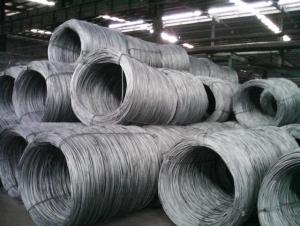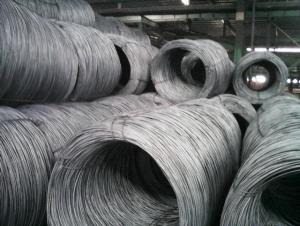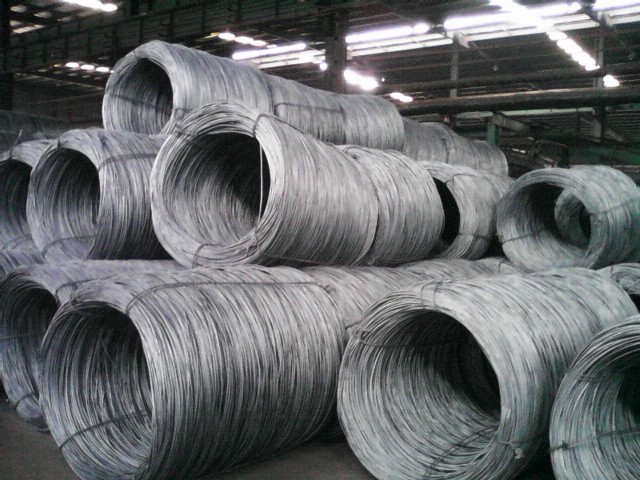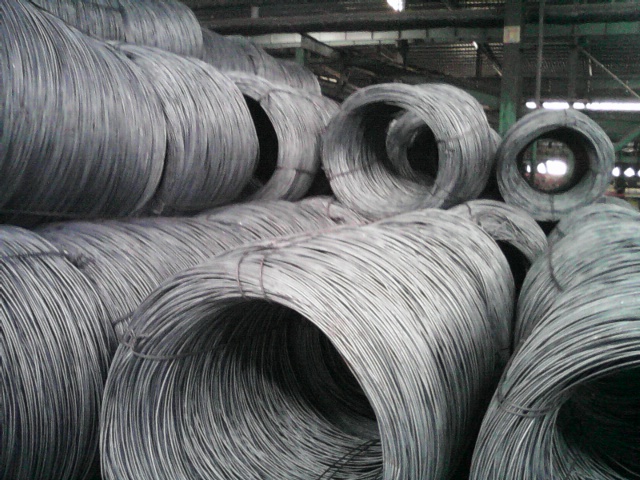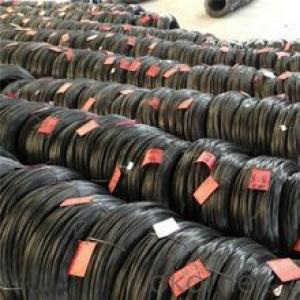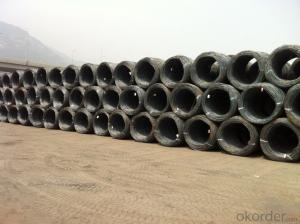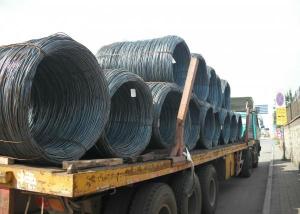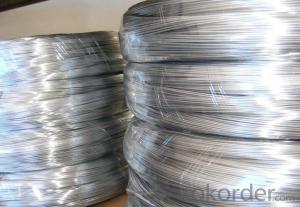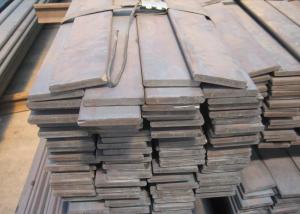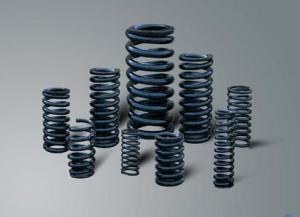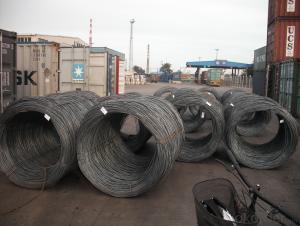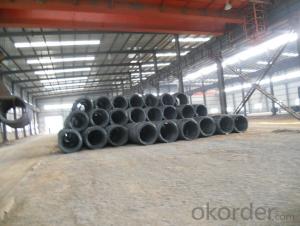WIRE ROD
- Loading Port:
- China Main Port
- Payment Terms:
- TT OR LC
- Min Order Qty:
- -
- Supply Capability:
- -
OKorder Service Pledge
OKorder Financial Service
You Might Also Like
Steel Grade: Q195 Standard: ASTM, GB
Diameter: 5.5mm, 6.5mm, 7mm,8mm,9mm,10mm,12mm,14mm
6.5mm can be drawing into 2mm/8.0mm can be drawing into 3mm
Type: Drawn Wire in Coil, each coil weight about 2MT
Brand Name: N-RIVER Place of Origin: Hebei, China
Chemical Composition:
Please kindly find our chemistry of our material based on Q195 as below for your information
Trademark | Rank | Chemical composition (quality score) % | | ||||
C | Si | Mn | S | P | | ||
| | |||||||
| ≤ |
| ≤ | ≤ | | ||
Q195 |
| 0.06-0.12 | 0.30 | 0.25 | 0.050 | 0.045 | |
Trademark | Rank | Pulling Test | | ||||
Bend PointΔs/Mpa | Tensile Strength | Elongation Ratioδ5% | | ||||
| | |||||||
Thickness (Diameter) /MM | Thickness (Diameter) /MM | | |||||
≤16 | 16-40 | | ≤16 | 16-40 | | ||
≥ | | ≥ | | ||||
Q195 |
| 195 | 185 | 315-390 | 33 | 32 | |
Usage and Applications of Wire Rod Q195:
After hot-rolled the products shaped into coil and delivery as finished product, including round, square, rectangular, hexagonal and so on. Since most of the products are round, it is generally called wire rod. Carbon steel wire rod is widely used in construction and manufacturing. Carbon steel wire rod is mainly used for reinforcement of reinforced concrete and welded structure or reprocessed (roberts , nail, etc.) materials, especially used to produce wire drawing, welding electrode, nails, spring, electronic, precise machinery parts and so on
- Q: What are the different types of steel wire rod surface defects after wire drawing?
- There are several types of surface defects that can occur on steel wire rods after the wire drawing process. These defects can be classified into various categories based on their appearance and causes. 1. Scratches: Scratches are linear marks on the surface of the wire rod that can occur during the drawing process. They are typically caused by abrasive particles or contact with sharp edges of the drawing dies. 2. Scale: Scale refers to the thin layer of oxide that forms on the surface of the wire rod during the heating and rolling processes. It can create a rough and uneven surface, affecting the wire rod's appearance and performance. 3. Pitting: Pitting defects appear as small depressions or pits on the surface of the wire rod. They are typically caused by localized corrosion or uneven cooling of the wire rod during the manufacturing process. 4. Flakes: Flakes are irregularly shaped, thin pieces of metal that detach from the surface of the wire rod. They are often caused by excessive friction between the wire rod and the drawing dies, leading to material detachment. 5. Decarburization: Decarburization occurs when the carbon content in the steel wire rod reduces on the surface due to exposure to high temperatures during the manufacturing process. This can result in a weakened structure and reduced mechanical properties. 6. Laps: Laps are irregularities on the surface of the wire rod that occur due to folding or overlapping of the material during the drawing process. They can weaken the wire rod's structure and lead to premature failure. 7. Grooves: Grooves appear as deep, narrow channels on the surface of the wire rod. They can be caused by uneven wear of the drawing dies or abrasive particles present during the drawing process. 8. Coating defects: In some cases, wire rods may have a coating applied to protect against corrosion. Coating defects can include peeling, blistering, or uneven application, which can compromise the corrosion resistance of the wire rod. It is important to note that these defects can affect the quality and performance of the wire rod. Manufacturers often employ various quality control measures and inspections to identify and address these defects to ensure the production of high-quality wire rods.
- Q: What are the different weldability testing methods for steel wire rod?
- Steel wire rod can be tested for weldability using various methods. These methods aim to evaluate the welding suitability and quality of the steel. Some commonly used tests for steel wire rod include: 1. Tensile Test: This test involves gradually applying force to a welded specimen until it breaks. The tensile strength and elongation of the weld are then measured to assess its quality. 2. Bend Test: A welded specimen is bent to a specific angle and checked for cracks or fractures. This test assesses the weld's ductility and resistance to cracking. 3. Charpy Impact Test: This test measures the impact strength of the weld by striking a notched specimen with a pendulum. The energy absorbed during fracture determines the weld's toughness. 4. Hardness Test: The Rockwell or Brinell hardness testing methods are used to assess the weld's hardness. This test indicates the weld's strength and brittleness by measuring its resistance to indentation. 5. Macroscopic Examination: The welded specimen is visually inspected for defects such as cracks, inclusions, or lack of fusion. A magnifying lens or microscope may be used for detailed examination. 6. Microscopic Examination: The microstructure of the weld is examined using a microscope. This examination provides information about the grain structure, presence of impurities, and potential defects. 7. Non-Destructive Testing (NDT): NDT methods like ultrasonic testing, magnetic particle testing, or dye penetrant testing can detect internal or surface defects in the weld without damaging the specimen. These weldability testing methods ensure that steel wire rod welds meet the required standards for their intended applications, guaranteeing their quality and performance.
- Q: How is steel wire rod used in the manufacturing of wire rope assemblies for mining applications?
- Steel wire rod is a crucial component in the manufacturing of wire rope assemblies for mining applications. These wire rope assemblies are used in various mining operations to lift and transport heavy loads, provide stability and support, as well as ensure the safety of workers. The first step in the manufacturing process is the production of steel wire rod. This involves melting steel scrap in a furnace and then continuously casting the molten steel into billets or blooms. These billets are then hot rolled into long, thin rods with diameters ranging from a few millimeters to several centimeters. Once the steel wire rod is produced, it undergoes a series of processes to transform it into wire rope. The first step is wire drawing, where the rod is pulled through a series of dies to reduce its diameter and increase its length. This process also improves the wire's surface finish and mechanical properties. After wire drawing, the steel wire is typically coated with a lubricant to reduce friction and enhance corrosion resistance. The lubricant also helps to protect the wire during subsequent manufacturing processes. Next, the wire is twisted together to form strands. The number of strands and the design of the twist pattern depend on the specific application and required strength of the wire rope assembly. The strands are then helically laid around a central core, which provides additional strength and support. Finally, the wire rope assembly undergoes a process called closing, where the entire length of the assembly is compressed to ensure that all the strands are tightly packed and securely held together. This closing process also helps to improve the overall structural integrity of the wire rope assembly. In mining applications, wire rope assemblies made from steel wire rod are used in various ways. They are commonly used in hoisting systems to lift heavy loads such as equipment, ore, and personnel. These assemblies are also employed for suspension and support purposes, such as providing stability to underground tunnels and shafts. Additionally, wire rope assemblies are used in safety applications, such as fall protection systems and rescue operations. Overall, steel wire rod plays a critical role in the manufacturing of wire rope assemblies for mining applications. Its high strength, durability, and flexibility make it an ideal material for withstanding the demanding conditions and heavy loads commonly encountered in the mining industry.
- Q: How is steel wire rod used in the production of wire mesh baskets for industrial applications?
- Steel wire rod is a crucial component in the production of wire mesh baskets for industrial applications. The wire rod serves as the primary raw material from which the wire mesh is created. To manufacture wire mesh baskets, the steel wire rod is first drawn through a series of dies to reduce its diameter and increase its length. This process is known as wire drawing and results in a long, continuous wire that is thinner and more malleable than the original rod. The drawn wire is then fed into a machine that weaves it into a mesh pattern, creating a flexible and sturdy structure. The size of the mesh can vary depending on the specific requirements of the application. Once the wire mesh is formed, it is typically cut into the desired shape and size to create the basket. The wire mesh can be easily manipulated and bent into various configurations, making it ideal for constructing baskets with specific dimensions and designs. The steel wire rod used in the production of wire mesh baskets is chosen for its high strength and durability. Industrial applications often require baskets capable of withstanding heavy loads or harsh environments, and steel wire provides the necessary strength and resilience. Furthermore, the wire mesh structure allows for excellent visibility and airflow, making it suitable for applications such as storage, transportation, and handling of various industrial goods. It provides a secure containment while allowing easy inspection and ventilation. In conclusion, steel wire rod is an essential material in the production of wire mesh baskets for industrial applications. Its versatility, strength, and durability make it an ideal choice for creating baskets capable of withstanding demanding conditions and effectively storing and transporting goods.
- Q: How is the steel wire rod market affected by mergers and acquisitions?
- The steel wire rod market can be significantly affected by mergers and acquisitions. When companies merge or acquire other companies in the industry, it often leads to consolidation and concentration of market share. This can result in increased pricing power, reduced competition, and a more streamlined supply chain. Additionally, mergers and acquisitions can also lead to the integration of complementary technologies and expertise, which may enhance the overall efficiency and innovation in the market. However, it is important to note that such transactions require regulatory approvals and can lead to potential challenges in terms of market competition and fair pricing practices.
- Q: How is steel wire rod used in the manufacturing of wire mesh strainers?
- Steel wire rod is used in the manufacturing of wire mesh strainers as it serves as the primary material for creating the mesh. The steel wire rod is first drawn into thinner wires, which are then woven or welded together to form the mesh structure of the strainer. This provides strength, durability, and flexibility to the strainer, enabling it to effectively strain out particles or debris while allowing liquid or air to pass through.
- Q: How is steel wire rod used in the production of wire mesh for agricultural fencing?
- Steel wire rod is used in the production of wire mesh for agricultural fencing by being drawn into thin, continuous strands that are then woven or welded together to create a strong and durable mesh. This mesh is used to form the structure of the agricultural fence, providing a barrier that secures livestock and crops while also allowing visibility and airflow. The high tensile strength and corrosion resistance of steel wire rod make it an ideal choice for withstanding the harsh outdoor conditions and ensuring the longevity of the wire mesh fencing.
- Q: How are steel wire rods used in the production of wire hangers for hanging clothes?
- Steel wire rods are an essential component in the production of wire hangers for hanging clothes. These rods are typically made from high-quality, durable steel, which provides the necessary strength and rigidity to support the weight of garments. The first step in the production process involves cutting the steel wire rods into the desired length for the hangers. This can be done using specialized machinery or through manual cutting methods. Once the rods are cut, they are then bent into the familiar hanger shape, typically using a combination of automated bending machines and skilled workers. The steel wire rods are manipulated and shaped to form the top hook of the hanger, which allows it to be hung on a closet rod or other hanging mechanisms. Additionally, the rods are bent to form the curved body of the hanger, which provides a secure and stable structure for hanging clothes. After the basic shape of the hanger is formed, the steel wire rods may undergo additional processes to improve their functionality and aesthetics. This may include coating the rods with a layer of protective material, such as plastic or vinyl, to prevent rusting and provide a smooth surface for hanging delicate fabrics. The hangers can also be painted or coated with a variety of colors or finishes to match different branding or aesthetic preferences. Overall, steel wire rods play a crucial role in the production of wire hangers for hanging clothes. Their strength, durability, and versatility make them an ideal material for creating hangers that can support a wide range of garments. Whether it's in homes, retail stores, or laundry facilities, wire hangers made from steel wire rods are a staple tool for organizing and displaying clothes.
- Q: How is steel wire rod used in the manufacturing of wire forms for sliding doors?
- Steel wire rod is an essential component in the manufacturing of wire forms for sliding doors. It serves as the primary material for creating the framework and structure of the wire forms. Firstly, steel wire rod is selected for its high tensile strength and durability, making it an ideal material for withstanding the constant movement and stress that sliding doors experience. The wire rod undergoes a series of processes, including drawing and annealing, to enhance its mechanical properties and ensure it meets the required specifications. Next, the steel wire rod is formed into various shapes and sizes, depending on the specific design and requirements of the wire forms. This can be achieved through bending, cutting, and welding techniques. The wire rod is manipulated to create the necessary curves, angles, and dimensions needed to construct the sliding door wire forms. Once the wire forms are shaped, they are further processed to enhance their functionality and aesthetics. This may involve surface treatments such as galvanizing or coating to provide corrosion resistance and improve the overall appearance of the wire forms. Finally, the wire forms are assembled and integrated into the sliding door system. They are typically used to support the door panels, guide the movement of the doors along the tracks, and provide stability and smooth operation. The steel wire rod ensures that the wire forms can withstand the weight of the door panels and endure frequent opening and closing without deformation or failure. In summary, steel wire rod plays a vital role in the manufacturing of wire forms for sliding doors by providing strength, durability, and flexibility. It serves as the backbone of the wire forms, enabling them to function effectively and contribute to the overall performance of sliding doors.
- Q: How are steel wire rods used in the production of wire ropes for cranes?
- Wire ropes for cranes heavily rely on steel wire rods, which act as a crucial ingredient. These rods function as the primary material in the wire rope manufacturing process. Initially, careful selection of steel wire rods is based on their mechanical properties, such as strength and durability. Subsequently, a sequence of processes, including cleaning, heating, and drawing, is applied to transform the rods into wire strands. After the formation of wire strands, they are tightly wound together to create the wire rope. This procedure entails intertwining numerous strands around a central core, typically composed of fiber or steel. The arrangement of the wire strands in a helical pattern enhances both the strength and flexibility of the wire rope. The steel wire rods specifically chosen for the production of wire ropes for cranes possess high tensile strength. This ensures that the wire ropes can endure heavy loads and extreme working conditions. The strength of the steel wire rods directly impacts the overall strength and safety of the wire ropes. Moreover, during the manufacturing process, the steel wire rods undergo various quality control measures to ensure their dependability and consistency. These measures entail testing for tensile strength, breaking load, and other performance parameters. Once the wire ropes are manufactured using the steel wire rods, they find utility in a wide range of crane applications. Wire ropes are indispensable for lifting and transporting heavy loads, providing stability and control throughout crane operations. They play a critical role in the secure and efficient lifting, lowering, and suspension of loads in diverse construction, industrial, and maritime settings. In conclusion, steel wire rods are an essential part of wire rope production for cranes, as they deliver the necessary strength, durability, and reliability required in demanding work environments.
Send your message to us
WIRE ROD
- Loading Port:
- China Main Port
- Payment Terms:
- TT OR LC
- Min Order Qty:
- -
- Supply Capability:
- -
OKorder Service Pledge
OKorder Financial Service
Similar products
Hot products
Hot Searches
Related keywords
